For the 2025 school year, there is 1 public school serving 428 students in Cedar Tree Academy PCS School District.
Public Schools in Cedar Tree Academy PCS School District have a diversity score of 0.17, which is less than the District Of Columbia public school average of 0.55.
Minority enrollment is 100% of the student body (majority Black), which is more than the District Of Columbia public school average of 87% (majority Black).
Overview
This School District
This State (DC)
# Schools
1 School
244 Schools
# Students
428 Students
92,092 Students
# Teachers
28 Teachers
8,291 Teachers
Student : Teacher Ratio
15:1
15:1
District Rank
Math Test Scores (% Proficient)
(12-13)42%
53%
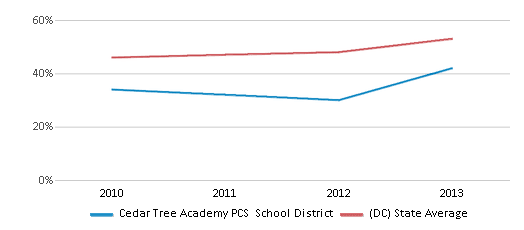
Reading/Language Arts Test Scores (% Proficient)
(12-13)35%
49%

Students by Ethnicity:
Diversity Score
0.17
0.55
# American Indian Students
3 Students
138 Students
% American Indian Students
1%
n/a
# Asian Students
n/a
1,342 Students
% Asian Students
n/a
2%
# Hispanic Students
11 Students
17,048 Students
% Hispanic Students
3%
19%
# Black Students
389 Students
58,484 Students
% Black Students
91%
63%
# White Students
2 Students
12,350 Students
% White Students
n/a
13%
# Hawaiian Students
n/a
49 Students
% Hawaiian Students
n/a
n/a
# Two or more races Students
23 Students
3,058 Students
% of Two or more races Students
5%
3%
Students by Grade:
# Students in PK Grade:
170
12,099
# Students in K Grade:
99
7,192
# Students in 1st Grade:
83
7,151
# Students in 2nd Grade:
76
7,103
# Students in 3rd Grade:
-
6,760
# Students in 4th Grade:
-
6,407
# Students in 5th Grade:
-
6,293
# Students in 6th Grade:
-
5,910
# Students in 7th Grade:
-
5,647
# Students in 8th Grade:
-
5,549
# Students in 9th Grade:
-
7,301
# Students in 10th Grade:
-
5,663
# Students in 11th Grade:
-
4,813
# Students in 12th Grade:
-
3,953
# Ungraded Students:
-
251
District Revenue and Spending
The revenue/student of $29,058 in this school district is less than the state median of $31,299. The school district revenue/student has stayed relatively flat over four school years.
The school district's spending/student of $21,234 is less than the state median of $31,192. The school district spending/student has stayed relatively flat over four school years.
Total Revenue
$12 MM
$2,882 MM
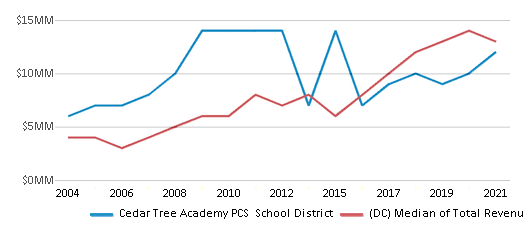
Spending
$9 MM
$2,873 MM
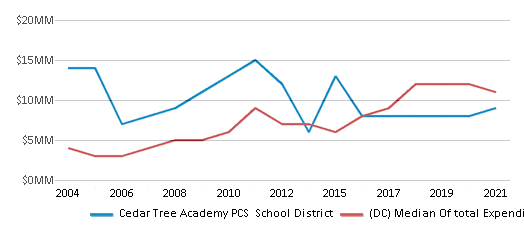
Revenue / Student
$29,058
$31,299
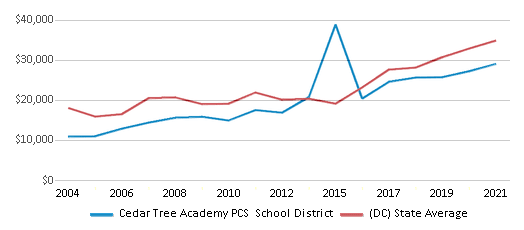
Spending / Student
$21,234
$31,192
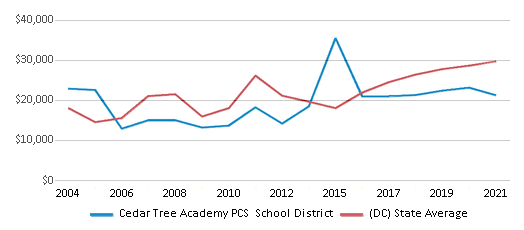
Best Cedar Tree Academy PCS School District Public Schools (2025)
School
(Math and Reading Proficiency)
(Math and Reading Proficiency)
Location
Grades
Students
Rank: #11.
Cedar Tree Academy Pcs
Charter School
(Math: 31% | Reading: 27% )
Rank:
Rank:
2/
Bottom 50%10
701 Howard Road Se
Washington, DC 20020
(202) 610-4193
Washington, DC 20020
(202) 610-4193
Grades: PK-2
| 428 students
Frequently Asked Questions
How many schools belong to Cedar Tree Academy PCS School District?
Cedar Tree Academy PCS School District manages 1 public schools serving 428 students.
What is the racial composition of students in Cedar Tree Academy PCS School District?
91% of Cedar Tree Academy PCS School District students are Black, 5% of students are Two or more races, 3% of students are Hispanic, and 1% of students are American Indian.
What is the student/teacher ratio of Cedar Tree Academy PCS School District?
Cedar Tree Academy PCS School District has a student/teacher ratio of 15:1, which is higher than the District Of Columbia state average of 11:1.
What is Cedar Tree Academy PCS School District's spending/student ratio?
The school district's spending/student of $21,234 is less than the state median of $31,192. The school district spending/student has stayed relatively flat over four school years.
Recent Articles

Year-Round Or Traditional Schedule?
Which is more appropriate for your child? A year-round attendance schedule or traditional schedule? We look at the pros and cons.

Why You Should Encourage Your Child to Join a Sports Team
Participating in team sports has a great many benefits for children, there is no doubt. In this article you will learn what those benefits are.

White Students are Now the Minority in U.S. Public Schools
Increasing birth rates among immigrant families from Asia and Central and South America, combined with lower birth rates among white families, means that for the first time in history, public school students in the United States are majority-minority. This shift in demographics poses difficulties for schools as they work to accommodate children of varying language abilities and socio-economic backgrounds.





